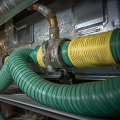Heating, Ventilation, and Air Conditioning (HVAC) systems are essential for providing comfortable temperatures in homes and businesses. The system is composed of several components that work together to regulate the temperature. To ensure your HVAC system is running efficiently, it is important to understand the four main components: the compressor, condenser, expansion valve, and evaporator coil. The compressor is the heart of the air conditioning system and does most of the work. It is responsible for compressing the refrigerant gas and transferring it to the condenser.
The condenser is the heat exchanger that serves as the hot side of the air conditioning unit. It removes heat from the building and transfers it to the outside. The expansion valve is an essential part of the condenser's function. It removes the pressure of the liquid coolant so that expansion can take place, converting it into vapor.
The evaporator coil contains the cooled refrigerant received from the compressor. As air passes over it, heat is removed from the air in the treated area. The thermostat is also an important component of an HVAC system. It is a thermometer with a direct connection to the heating and cooling components, allowing you to control when the oven and air conditioner turn on. There are many types of thermostats available today, including programmable models that automatically change the temperature depending on your settings. The oven motor and fan are two other components of a home air conditioning system.
The oven has a heat exchanger which starts up when the thermostat asks for heat. If it runs on gas or oil, burners perform the heating, while electric coils heat up if electricity is used as fuel source. The outdoor condensing unit is responsible for expelling heat absorbed from indoor air to the outside. Refrigerant lines composed of copper or aluminum extend between the indoor evaporator coil and outdoor condensing unit. Forced air heating and cooling rely on ducts to distribute air conditioning throughout a house. Ducts should not go through attics, garages or mezzanines if possible, as they must be sealed and isolated to prevent them from being affected by major temperature differences between these areas and living space. You can keep your HVAC system in good condition by checking frequently for refrigerant leaks, preventing contamination by dirt, keeping condenser coils clean, and keeping your air conditioner well-oiled. Understanding how your HVAC system works will help you maintain it properly and ensure it runs efficiently for years to come.


